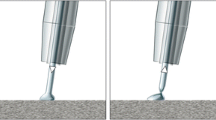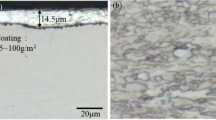Abstract
In electromagnetic welding process, for a low electrically conductive outer tube material, physical and mechanical properties of conductive drivers are important to achieve strong wavy weld. However, the technology may not be cost-effective for joining such metals. This work investigates the effect of using driver materials (Al of thickness 0.65, 1.0, 1.3, and 2.0 mm and annealed Cu (up to 650°C) of thickness 0.5, 0.75, 1.0, and 1.5 mm) on effectively achieving welding between alloy D9 SS tube and SS316L(N) solid plug. Multiple experiments were conducted to determine the preferred material and thickness of the driver tube. The welded interface revealed a wavy morphology of 35–40 μm as maximum crest height and lowest helium leak rate of 4 × 10–10 m bar L/s with annealed Cu driver having thickness 1 mm. The experimental results prove that annealed Cu (up to 650°C) should be chosen over Al as driver material. The preferred driver thickness was found to be dependent on the frequency of the current pulse.










Similar content being viewed by others
References
Kapil A, Lee T, Vivek A, Bockbrader J, Abke T, Daehn G (2014) Benchmarking strength and fatigue properties of spot impact welds. J Mater Process Technol 255:219–233. https://doi.org/10.1016/j.jmatprotec.2017.12.012
Wu X, Shang J (2014) An investigation of magnetic pulse welding of Al/Cu and interface characterization. J Manuf Sci Eng 136(5):051002. https://doi.org/10.1115/1.4027917
Xu Z, Cui J, Yu H, Li C (2013) Research on the impact velocity of magnetic impulse welding of pipe fitting. Mater Des 49:736–745. https://doi.org/10.1016/j.matdes.2012.12.059
Kore SD, Date PP, Kulkarni SV (2008) Electromagnetic impact welding of aluminum to stainless steel sheets. J Mater Process Technol 208(1-3):486–493. https://doi.org/10.1016/j.jmatprotec.2008.01.039
Mannan SL, Chetal SC, Raj B, Bhoje SB (2003) Selection of materials for prototype fast breeder reactor. Trans Indian Inst Met 56(2):155–178
Khan MR, Hossain MM, Sharma A, Kumar S (2018) Predicting the effect of field shaper in electromagnetic welding using FEM. Arab J Sci Eng 44(2):1129–1136. https://doi.org/10.1007/s13369-018-3430-9
Khan MR, Hossain MM, Sharma A, Kumar S (2019) Sequential coupling of electromagnetic–structural simulation for compression welding of tubular jobs. Proc Inst Mech Eng C J Mech Eng Sci 233(10):3346–3355. https://doi.org/10.1177/0954406218813445
Xu JR, Cui JJ, Lin Q, Li CF (2014) Effects of driver sheet on magnetic pulse forming of AZ31 magnesium alloy sheets. Int J Adv Manuf Technol 72(5-8):791–800. https://doi.org/10.1007/s00170-014-5713-y
Gies S, Weddeling C, Tekkaya AE (2014) Experimental investigations on the optimum driver configuration for electromagnetic sheet metal forming. 6th International Conference on High Speed Forming. Universitätsbibliothek Dortmund, Germany
Desai SV, Kumar S, Satyamurthy P, Chakravartty JK, Chakravarthy DP (2011) Improvement of performance of Electromagnetic welding process by use of driver materials. Int J Appl Electromagn Mech 35(2):113–121. https://doi.org/10.3233/JAE-2011-1325
Kore SD, Date PP, Kulkarni SV, Kumar S, Rani D, Kulkarni MR, Desai SV, Rajawat RK, Nagesh KV, Chakravarty DP (2011) Application of electromagnetic impact technique for welding copper-to-stainless steel sheets. Int J Adv Manuf Technol 54(9-12):949–955. https://doi.org/10.1007/s00170-010-2981-z
Furth HP, Levine MA, Waniek RW (1957) Production and use of high transient magnetic fields. II. Rev Sci Inst 28(11):949–958. https://doi.org/10.1063/1.1715773
Knoepfel H (1970) Pulsed high magnetic fields. North-Holland publishing company, Amsterdam and London
Bourcey N, Campos P, Chiggiato P, Limon P, Mongelluzzo A, Musso G, Poncet A, Parma V (2008) Leak-tight welding experience from the industrial assembly of the LHC cryostats at CERN. AIP Conf Proc 985(1):325–332. https://doi.org/10.1063/1.2908564
Nassiri A, Chini G, Vivek A, Daehn G, Kinsey B (2015) Arbitrary Lagrangian–Eulerian finite element simulation and experimental investigation of wavy interfacial morphology during high velocity impact welding. Mater Des 88:345–358. https://doi.org/10.1016/j.matdes.2015.09.005
(2010) N.N: Manual Comsol Multiphysics 3.5a: AC/DC Module: “Inductance of a coil”
Haiping YU, Chunfeng LI, Jianghua DE (2009) Sequential coupling simulation for electromagnetic–mechanical tube compression by finite element analysis. J Mater Process Technol 209(2):707–713. https://doi.org/10.1016/j.jmatprotec.2008.02.061
Maloberti O, Sansen P, Jouaffre D, Haye D (2018) Magneto-mechanical-thermal couplings for the pulsed magnetic technology with single-turn coils. Excerpt from the Proceedings of the 2018 COMSOL Conference, Lausanne, Switzerland
Acknowledgments
Authors would like to thank Mr. R.K. Rajawat, Associate Director, Beam Technology Development Group, Bhabha Atomic Research Center (BARC), Mumbai, for his continuous support and guidance. Authors are thankful to M.R. Kulkarni, Hitesh Choudhary, and S. K. Dond for useful discussions during experimentations. Authors are also thankful to Dr. A. Laik and K. Shrikant for their help in optical microscopy of welded samples.
Funding
The work was supported by the Advanced Technology Committee of BRNS Mumbai, India (grant number 2015013407RP00729-BRNS).
Author information
Authors and Affiliations
Corresponding author
Ethics declarations
Conflict of interest
The authors declare that they have no conflict of interest.
Additional information
Publisher’s note
Springer Nature remains neutral with regard to jurisdictional claims in published maps and institutional affiliations.
Rights and permissions
About this article
Cite this article
Kumar, S., Khan, M.R., Saroj, P.C. et al. Experimental investigation of driver material on electromagnetic welding of alloy D9 SS tube to SS316L(N) plug. Int J Adv Manuf Technol 105, 4225–4235 (2019). https://doi.org/10.1007/s00170-019-04525-0
Received:
Accepted:
Published:
Issue Date:
DOI: https://doi.org/10.1007/s00170-019-04525-0




